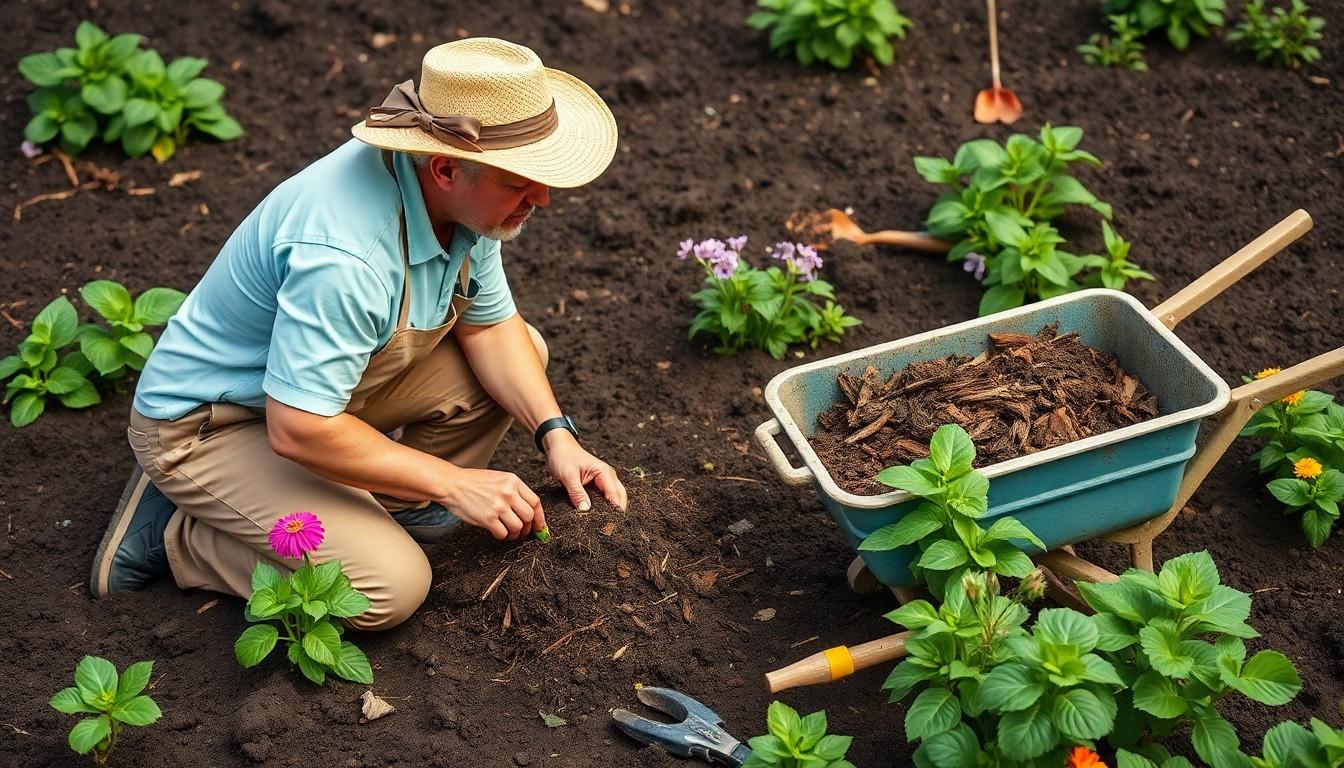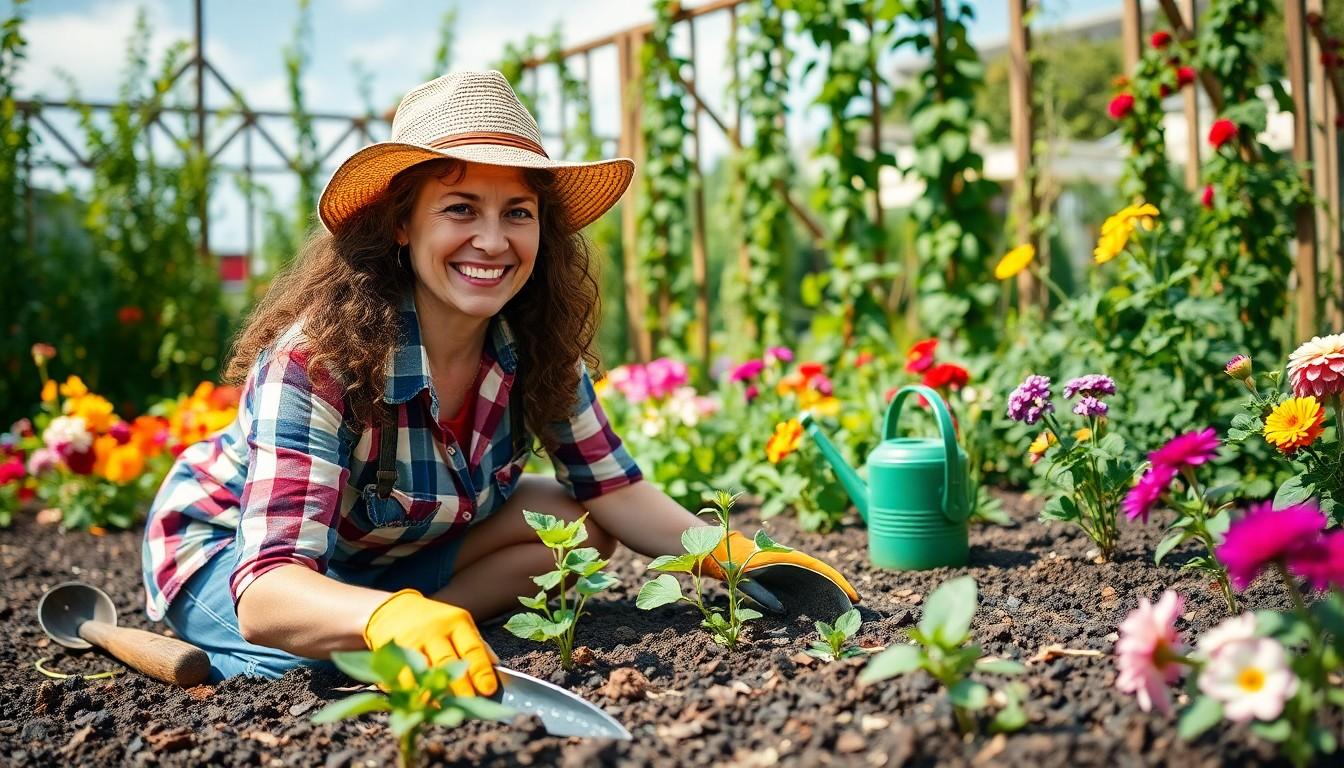Gardening can feel like a never-ending battle against weeds, pests, and the occasional rogue squirrel. But what if there’s a way to turn that struggle into a triumph? With a little creativity and some clever tips, anyone can transform their garden into a flourishing paradise that even Mother Nature would envy.
14 Most Clever Gardening Tips and Ideas
Gardening tips often transform how one approaches plant care. Effective techniques make it easier to manage common challenges. Utilize companion planting to deter pests naturally. Incorporate mulch to retain moisture and suppress weed growth.
Plan garden layouts strategically to maximize space and sun exposure. Use containers for flexibility and portability. Selecting the right plants for the climate is crucial for success. Employ a compost system to recycle organic waste and enrich soil.
Monitoring moisture levels helps prevent over or underwatering. Install a rain barrel to collect water and reduce utility costs. Consider using natural insect repellents, such as neem oil or garlic spray, to protect plants. Applying baking soda or dish soap can also help combat fungal issues.
Creating a routine for regular maintenance ensures a garden stays healthy. Using tools like drip irrigation systems can save time and resources. Training plants vertically optimizes space and eases harvesting. Engaging in seasonal planting provides continuous food production.
Mixing native plants with traditional varieties enhances garden resilience. Observing plant behavior enables better care responses. Adapting gardening styles to different environments fosters creativity and innovation. Each of these tips contributes to a sustainable, flourishing garden environment.
Preparing Your Garden
Preparing a garden involves careful planning and attention to various critical factors. Gardeners should focus on enhancing soil quality and identifying optimal planting times for best results.
Soil Enhancements
Improving soil health is fundamental for a thriving garden. Incorporating organic compost enriches soil structure and boosts nutrient levels. Adding mulch helps retain moisture and suppresses weed growth. Soil testing provides insights into pH levels and nutrient deficiencies. Incorporating organic matter, such as leaf mold or aged manure, enhances aeration and drainage. Using cover crops can naturally replenish nutrients and prevent erosion. Implementing these enhancements creates fertile ground for plants to flourish.
Ideal Planting Times
Timing plays a crucial role in planting success. Understanding local frost dates helps determine the best planting schedule. Warm-season crops, like tomatoes and peppers, thrive when soil temperatures reach 60°F or higher. Cool-season crops, such as peas and lettuce, perform well when planted early in spring or late summer. Monitoring seasonal weather patterns influences when to sow seeds for optimal growth. Aligning planting with moon phases may also enhance seed germination. Recognizing these factors supports effective garden management and promotes healthy plant development.
Clever Planting Techniques
Clever planting techniques can make a significant difference in garden productivity. Implementing these strategies helps maximize space and plant health.
Companion Planting
Companion planting involves pairing plants that benefit each other, improving growth while minimizing pest issues. For instance, basil grows well alongside tomatoes, enhancing their flavor and deterring harmful insects. Marigolds attract beneficial pollinators while repelling nematodes and aphids. Enhancing biodiversity promotes a balanced ecosystem in the garden. By selecting appropriate companions, gardeners can reduce reliance on chemical pest control and encourage healthier plants. Researching plant compatibility ensures effective pairing, contributing to a thriving garden environment.
Vertical Gardening
Vertical gardening optimizes limited space, making it ideal for urban environments or smaller yards. Utilizing structures like trellises, shelves, or wall-mounted pots allows plants to grow upward rather than outward. This approach not only maximizes space, but also improves sunlight exposure and air circulation. Growing vining plants such as peas, cucumbers, or tomatoes on supports showcases creativity in garden design. Incorporating vertical elements can transform a plain garden into an aesthetically pleasing display. Regular maintenance and monitoring ensure healthy growth and productivity.
Efficient Watering Strategies
Watering efficiently ensures healthy plants and reduces resource waste in the garden. Implementing effective methods maximizes moisture retention while minimizing effort.
Drip Irrigation
Drip irrigation delivers water directly to the root zone of plants. This targeted approach minimizes evaporation and runoff. Using drip lines or tubes, gardeners can distribute water evenly, allowing for precise control over moisture levels. It’s particularly beneficial for raised beds and container gardens, where consistent watering plays a crucial role in plant health. Studies show that drip irrigation can save up to 50% more water compared to traditional methods, making it an environmentally friendly choice. Gardeners often find that this technique improves crop yields and reduces disease, as foliage remains dry.
Rainwater Harvesting
Rainwater harvesting collects and stores rain for garden use. Setting up a rain barrel beneath gutters allows gardeners to gather water naturally. This practice not only conserves water but also provides free irrigation during dry spells. Over a year, a single barrel can collect hundreds of gallons, depending on rainfall. Utilizing collected rainwater for irrigating plants enriches soil health as it typically contains fewer chemicals than tap water. Many gardeners employ this strategy to promote sustainability and reduce utility bills. It’s an effective way to protect local waterways by reducing runoff and erosion.
Innovative Pest Control Methods
Gardening often requires innovative methods to manage pests effectively. Implementing natural solutions not only protects plants but also promotes a healthier ecosystem.
Natural Remedies
Essential oils serve as powerful natural repellents against various pests. For instance, peppermint oil deters spiders and ants, while neem oil can eliminate aphids and whiteflies. Garlic spray acts as a universal pest deterrent; it disrupts the scent trails used by many insects. Vinegar mixed with water works wonders in repelling ants and other crawling pests as well. Diatomaceous earth, a natural powder made from fossilized algae, proves effective against soft-bodied insects, leading to dehydration. Incorporating these remedies enhances pest control and minimizes the use of harmful chemicals.
Attracting Beneficial Insects
Beneficial insects play a crucial role in balancing the garden ecosystem. Ladybugs, for example, feast on aphids, reducing their population significantly. Planting flowers like marigolds attracts hoverflies, which lay their eggs among aphids, providing an additional layer of defense. Providing habitats, such as insect hotels, fosters a consistent presence of these helpful creatures. Native plants also draw pollinators like bees, improving overall plant health and productivity. Encouraging beneficial insects creates a natural pest management system that supports thriving plant life.
Creative Gardening Ideas
Gardening can take various forms to maximize space and creativity. Here are a couple of innovative concepts that enhance gardening experiences.
Container Gardening
Container gardening offers flexibility and versatility, making it ideal for small spaces like balconies or patios. Various pots and planters allow plants to thrive without traditional soil beds. Utilizing different container sizes promotes diversity, enabling the growth of herbs, flowers, and vegetables. Choosing lightweight materials simplifies mobility, making seasonal relocation easy. Additionally, adding drainage holes prevents overwatering, ensuring healthy roots. Opting for self-watering containers can minimize maintenance while maximizing moisture retention. Varieties like cherry tomatoes or ornamental peppers can flourish in these settings, providing beauty and utility. Furthermore, grouping containers creates an artistic display while improving microclimates for plants.
Herb Spiral Garden
An herb spiral garden maximizes vertical space while promoting biodiversity and efficiency. Designing this structure typically involves arranging bricks or stones in a spiral formation. This shape enhances drainage and sunlight exposure, making it perfect for a variety of herbs. Planting the sun-loving herbs at the top and moisture-loving plants at the bottom creates a microclimate. Frequent access ensures easy harvesting and maintenance of herbs like basil, thyme, and rosemary. Integrating companion plants encourages pest control, enhancing the overall garden health. As a result, an herb spiral garden becomes a functional, attractive element in any backyard. By incorporating this creative design, gardeners can enjoy fresh herbs while optimizing available space.
Gardening can be a rewarding endeavor filled with creativity and innovation. By implementing these clever tips and ideas, anyone can navigate common challenges and cultivate a vibrant garden. Whether it’s through efficient watering techniques or thoughtful planting strategies, every gardener can enhance their space and plant health.
Embracing natural pest control methods and sustainable practices not only promotes a thriving ecosystem but also contributes to long-term garden success. With a little planning and care, transforming any outdoor space into a flourishing haven is entirely achievable. Happy gardening!


